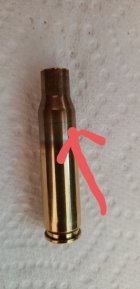Bill1973
Silver $$ Contributor
I'm new to reloading, and I'm trying to figure out if I have a problem with some brass that I purchased used. After annealing 350 pieces of Federal brass, about 1/3 of it had a dark line appear below the shoulder. I'm wondering if these are stress fractures or signs where the brass has been stressed?
I was told it was once fired brass from Federal Gold Medal Match ammunition. I have an additional 300 pieces of brass from FGGM ammunition that I purchased new, fired from my gun, annealed, and reloaded, and none of those pieces if brass have these marks.
After taking several measurements using a Hornady headspace guage, I noticed that the used brass I purchased was consistently. 01 inches longer at the shoulder than the brass fired from my bergara b14 hmr. Is this additional length enough to stress the brass and cause fractures?
My main questions are 1. What are the black lines in the brass? 2. What caused them? 3. Are they safe to reloading?
I appreciate your help and advice.
Thanks,
Bill
I was told it was once fired brass from Federal Gold Medal Match ammunition. I have an additional 300 pieces of brass from FGGM ammunition that I purchased new, fired from my gun, annealed, and reloaded, and none of those pieces if brass have these marks.
After taking several measurements using a Hornady headspace guage, I noticed that the used brass I purchased was consistently. 01 inches longer at the shoulder than the brass fired from my bergara b14 hmr. Is this additional length enough to stress the brass and cause fractures?
My main questions are 1. What are the black lines in the brass? 2. What caused them? 3. Are they safe to reloading?
I appreciate your help and advice.
Thanks,
Bill











